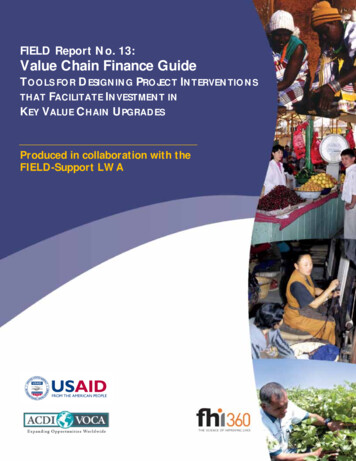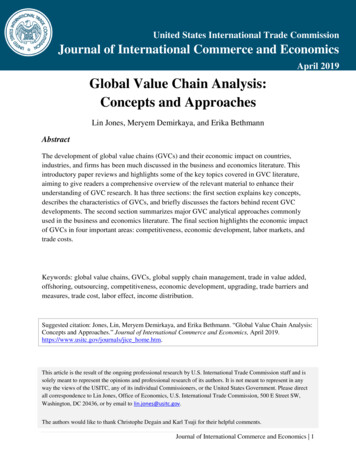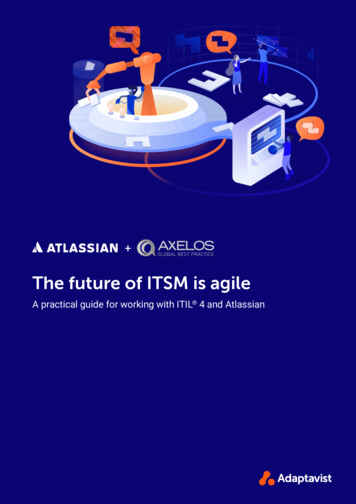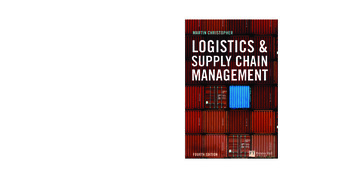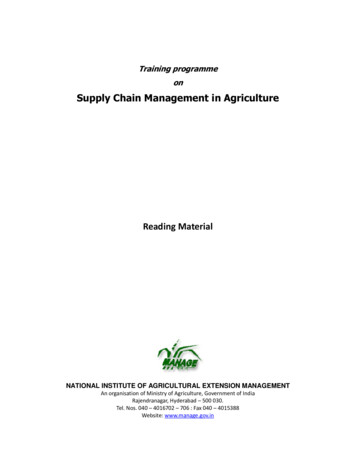
Transcription
Strakova, J., Simberova, I., Partlova, P., Vachal, J., & Zich, R. (2021). The Value Chain as the Basis ofBusiness Model Design. Journal of Competitiveness, 13(2), 135–151. https://doi.org/10.7441/joc.2021.02.08The Value Chain as the Basis of Business ModelDesign Jarmila Strakova, Iveta Simberova, Petra Partlova, Jan Vachal, RobertZichAbstractThe article presents a new approach to the generation of business models based on value streams.The originality of the study lies in the assumption that in every business model the generator ofadded value is the value chain which, if original enough, will maximize potential while minimizingcosts. This approach will provide the respective enterprise with a high level competitiveness inthe long term. The tested group of enterprises consisted of 354 SMEs, one hundred eightyseven of which were from the manufacturing and industry sector, with 167 from the servicessector. The novelty of this approach also consists of the integrated approach to the businessenvironment in which the value streams were analyzed. The results suggest that the analysisof value streams is suitable for the projection of business models. In addition, the methods ofdimensional reduction and logit regression have been identified as appropriate analytical tools,with representative results found valid and utilizable in business practice. The authors of thearticle are aware that this is only the first step in addressing this issue, one which will play acritical role in the gradual process of the upcoming digital transformation of all business models,not only those of SMEs in the Czech Republic.Keywords: business model, value chain, corporate environment, strateg y, digitization, competitivenessJEL Classification: L1, O14Received: September, 20201st Revision: February, 2021Accepted: March, 20211. INTRODUCTIONThere is no agreement among the academic community, and particularly not in the corporatesphere, concerning the definition and understanding of terms such as corporate strategy,business strategy, and business model. The authors of this paper consider the beginnings ofthe emergence of the business strategy to lie in the period after World War II, when JamesCulliton (in his paper The Management of Marketing Costs, 1948) and later Neil Borden (TheConcept of the Marketing Mix, 1964) came up with the idea of stipulating a product strategyand product portfolio using a marketing mix. Together with Kotler (with his book MarketingManagement, 2010), who was primarily responsible for popularizing this issue, these researcherlaid the foundations for defining the business strategy of an enterprise. After this beginning,135joc2021-2-v3.indd 13529.6.2021 14:27:45
various typological strategies came to be used in the literature on strategic management, withPorter’s market-oriented approaches becoming the most widely cited. The publications ofMichael Porter (Porter, 2012; Porter, 2015) and other authors (Rezapour et al., 2017; Yadavet al., 2017) represented a significant turning point in the approach to the strategies and theirgeneration. Porter defines a strategy as competitive in terms of a corporate strategy.Meskendahl (2010), Wirtz et al. (2016) describe a business strategy that addresses how theenterprises gain competitive advantage, how they decide to compete in the market, and whatbusiness model provides them with a competitive advantage. Yuan et al. (2020) emphasizedeveloping a business strategy with a focus on understanding and adapting to the business andmarket environment to maximize business performance. Ryu et al. (2015) propose to use one ofPorter’s three generic competitive strategies. Opinions on this issue continue to differ, althoughmost are based on Porter’s work. Porter (2015) has contributed to the way and frequency ofprojection and implementation of the business models, stating that a good analysis is crucialfor the creation of a competitive strategy. Still, it is not reasonable to create one in advance, asit may take several years to find an appropriate approach. He declared that any business issueshould be understood as a product of how the enterprise creates value for a customer. Theresearch priority of this topic consists of theoretical finalization and practical verification of abusiness model that uses the principle of generation of process added value for the customer toachieve a margin. This is based on a description of business processes, their decomposition inthe corporate environment, and subsequent value analysis to identify their contributions to theoverall margin. A recent aspect is the analysis of the corporate environment’s integrity, whichrespects a system approach to the enterprise, i.e. the authors propose an innovative method forthe development of a business strategy or business model based on an analysis of value streamsin a company with regard to the integral and unique system of the corporate environment. Thestructure of this article respects the research goal. A theoretical description of business modelsand associated mathematical and statistical methods (dimensional reduction and logit regression)is followed by the results of the research. The results section uses optimized logit models toidentify not only activities in the value chain that significantly influence the profitability of smalland medium enterprises, but also the effects of internal resources as well as the meso and macroenvironment, including the significance of these components in their integrated form. Finally,the research questions are answered and discussed based on the research outputs. The authorsalso suggest directions for future research activities in this field.2. Theoretical backgroundSmall and medium enterprises represent an important part of a national economic system.The quality of the business environment is critical for these firms, as it can create favorableconditions for their development (Dobes et al., 2017). Kozubikova & Kotaskova (2019) statethat business risks strongly affect the quality of the business environment in which small andmedium enterprises operate. These researchers conclude that the primary market risk is themost important risk of all. Lestari et al. (2020) state that for small enterprises, it is essential toset a goal and to share the sources and knowledge that are indispensable for the innovativeness136joc2021-2-v3.indd 136Journal of Competitiveness29.6.2021 14:27:45
of their projects and competitive advantage. Belas et al. (2014) have determined that small andmedium enterprises are prone to higher business risks because they are sensitive to changes inthe business environment. They explain that SME productivity is affected by obstacles, despitethe fact that their contribution to economic growth, employment, and competitiveness is highwithin the country in which they operate. In the Czech business environment, the terms businessand corporate strategy and business model are often confused, and they do in fact overlap.Apte & Davis (2019) define a business model as a comprehensive description of the principles ofthe creation, delivery, and representation of values in an enterprise. The importance of a businessmodel and its connections with a business strategy, innovation management, and economics isalso emphasized by Teece (2010). Massa et al. (2017) state that a business model which createsvalue for the customer and income for the enterprise mirrors the sources of the enterprise thatare grouped and arranged in a process producing the value. The relation between the corporatestrategy implemented and the business model is discussed by the authors Casadesus-Masanell& Ricart (2010). Another group of authors indicates that business models can be understoodas structured management tools that are considered decisive to corporate profitability andcompetitiveness (Kharub & Sharma, 2017; Wirtz et al., 2016). Porter defines the value chainas a powerful tool which makes it possible organize an enterprise into strategically importantactivities, resulting in the possibility of higher prices and lower costs (Kharub & Sharma, 2017).The concept of the value chain has also been discussed by a number of other authors, such asKalmykova et al. (2018), Feller et al. (2006), Missimer et al. (2017), and Kim & Chai, (2017).Understanding whether a business entity has the potential to create added value and whether itcan take advantage of this in the future is an essential step in diagnosing its potential (McNeish& Kelley, 2019). The research described above have laid the foundation for the study of businessmodel design. Academic works and examples from corporate practice have appeared showingthe organization of all categories of corporate strategies and models into a hierarchical andinterconnected model. Study results by Marx (2015) provide strong empirical evidence that theProduct Strategy (differentiation versus low costs), the Best Value Strategy, and the Blue OceanStrategy all have a significant influence on corporate management. Wal-Mart is an example ofan appropriately configured business model, ensuring as the most important part of the model“everyday low prices” for a wide range of products that are easily accessible and geographicallyadvantageous (Bhavik & Cespedes, 2016). The current process of generating a business strategyand business models has been deeply influenced by the business and information paradigm whichemerged at the beginning of the 21st century. It mirrors changes in the collection, storage, access,and transmission of information (Meskendahl, 2010; Wirtz et al., 2016; Gatautis, 2017), as well asincreasingly intensive processes of innovation and digitalization in the corporate environment.Demir et al. (2017) and Dagnino et al. (2017) discuss the increased pace of changes concerningthe innovations disrupting the established procedures in industrial branches; the researchershave noticed that the increased speed and intensity of the procedural changes may have aprofound impact on strategy and business models. A large number of authors have discussedthe progressive digitalization of business strategies (Wirtz et al., 2016; Bharadwaj et al., 2013)and business models (Masanell & Ricard, 2010; Wirtz et al., 2016). Significant changes have137joc2021-2-v3.indd 13729.6.2021 14:27:45
also occurred in the global and European market ring, such as the internationalization of trade,the end of globalization and the beginning of “glocalization,” and geographical changes fromthe viewpoint of global economic centers (Wisniewski & Brzezicka, 2020). Digitization as acurrent innovation process plays a crucial role in transforming the business models. It providesopportunities for adjusting higher quality and efficiency for the existing business processes andconnecting new processes to deliver the maximum added value (Sambit et al., 2017; Martins etal., 2015). Summing up the current degree of scientific knowledge in business modeling, there isno consensus in both the definition and the way of its projection of implementation in businesspractice. These two attributes were considered at the beginning of the scientific direction ofthe research by the authors of the paper, its goals, research methods, and the determination ofexpected theoretical and practical output.3. Research objective, methodology and dataTresearch aims to prepare a method for business practice for generating a business model ofa business using a value chain anchored in its integrated business environment. Two researchquestions were formulated, which will be decisive for further research in the field of businessstrategy generation.RQ1: Is it possible to use value chain analysis, including components of the corporateenvironment in their integrated form, as a basis for generating a business model?RQ2: Is sector differentiation of enterprises suitable and sufficient for the development of abusiness model?The sample consisted of a total of 354 SMEs. There were 75 micro-enterprises (up to 25 employees,21%), 167 small enterprises (25-50 employees, 47%), and 112 medium-sized enterprises (50to 250 employees, 32%) from the Czech Republic. The manufacturing and industry sectoraccounted for 187 of the small and medium-sized enterprises (52%), and the services sectoraccounted for 167 (48%) of them. Profitability was reported by 88% of the sample. The samplewas created from the corporate database of the Department of Management at the Institute ofTechnology and Business. This database was established in 2016 and continues to be expanded.Data collection was conducted primarily through a contact survey (70%) and, to a smallerdegree, electronic surveying (30%). In terms of their representativeness, the source data wereconsulted with representatives of the business community and the scientific community of therelevant field, including the Czech Statistical Office. The research started in 2016 in a period ofeconomic growth. The first stage was completed in 2019; currently, a follow-up research stagehas been underway in conditions of economic stagnation and pandemic crisis. To test valuechain activities and components of the corporate environment (internal corporate resources,the meso-environment and the general macro-environment), a dimensionality reductionmethod is used at first, which reduces information from multidimensional data to a smallernumber of variables (Cook & Lee, 1999; Chiaromonte, et al., 2002), and regression analyses (ageneral linear model) (Pourghasemi & Rahmati, 2018; Stoffel et al., 2017). The calculation ofdimensionality reduction is based on the inverse distribution F(x y). The statistical software138joc2021-2-v3.indd 138Journal of Competitiveness29.6.2021 14:27:45
“R” was used for calculation. A calculation method of dimensionality reduction known assliced inverse regression (SIR) is used in the analysis. After that, a general linear model (GLM),which makes it possible to express the relation between the dependent variable (in this case,it had a binomial distribution) and a set of explanatory variables (regressors) by means of aregression function, which is a linear function of unknown estimated parameters, was usedto determine the optimal model of components of the corporate environment defining thesignificance of selected internal corporate resources and meso-environmental and macroenvironmental factors. The “Statistica” software was used for calculation.The link functions used within the logit model (Pourghasemi & Rahmati, 2018):Xβ ln(μ/(1-μ)) (1)The integrated model takes account of various dependencies of the tested components of thecorporate environment.ER ICR MZE MAE company focus;glm(formula ER ICR MZE MAE company focus) (2)Explanatory notes: ER – economic result, ICR – internal resources (microenvironment),MZE – mesoenvironment, MAE – macroenvironment, VC – value chain. (Source: authors)4. Results and discussionThe results presented in the paper are based on the assumption that the sample enterpriseshave a corporate strategy, in many cases identical to the business strategy. The output structurerespects the fact that the enterprise operates, delivers products in the customer segment andachieves a margin. The business model is embedded in the enterprise architecture (createdmainly by the business environment). In the first part of the research, the value chain withinthe integrated business environment is analyzed. In the following part, the essential componentof the business environment is analyzed using the newly designed integrated model.Value chain – base of the business modelsDr(formula ER INL PRO OUL MARK ROS PUR STD HRM EI,data SS,PIS,method "sir") (3)Value chain variables: INL – input logistics, PRO – production, OUL – output logistics, MARK– marketing and sales, ROS – repair and other services, PUR – purchase/material management,STD – scientific and technical development, HRM – human resource management,EI – enterprise infrastructure, PIS – production and industry sector, SS – service sector,ER – economic result. (Source: authors)Table 1 shows sector differentiation in terms of the value chain activities tested with regardto their contribution to the creation of value added in the enterprise, in general to the valuecreating business processes.139joc2021-2-v3.indd 13929.6.2021 14:27:45
Tab. 1 – Dimensional reduction of business value and its impact on profitability in terms ofsector differentiation. Source: own researchDir1Dir1Manufacturing and IndustryServicesInput logistics-0.33510-0.01796Provision of services / production0.04738-0.21329Output logistics0.58855-0.14014Marketing and sales0.428650.20600Service and other ancillary ific and technological development0.183040.83710Human Resource Management-0.441560.07177Enterprise infrastructure-0.27755-0.14160Value chain activitiesIn the manufacturing and industry, output logistics, marketing and sales are the mostimportant activities having a positive impact on the profitability of the enterprises. Humanresources management and input logistics have a negative impact, possibly explained by theirunderestimation by the managers and the poor level of such activities. Increased attention will,for this reason, have to be paid to such activities in the future, with input logistics enhancedby the increasingly intensive process of digitalization and automation, and human resourcescurrently becoming something of a limit to the sustainability and further development of theenterprises since their resources are currently exhausted and will continue to be limited in thefuture. Different specifics are reflected in the services sector than in the manufacturing andindustry sector, with scientific and technical development and purchases labeled as the decisivevalue-creating activities. It might be the essential requirement for the enterprises in this sectorfor the accelerated transfer of new research knowledge into business practice. At the same time,purchases are a favored production activity in which the current situation must be stabilized,improved and rationalized with the application of information technology and digitalization.Tab. 2 – Significance of the value chain by the size of the sample. Source: own researchEstimateStd. Error Z valuePR( z )VC – micro-enterprises0.16231.5639-0.1040.917369VC – small enterprises4.26201.41833.0050.002655 **VC – medium-sized enterprises1.45870.8395-1.7380.08229 .VC – medium-sized and large enterprises2.18180.5198-4.1972.70e-05***As can be seen in Table 1 and the relevant commentary, sectoral differentiation in the sample wasnot proved. Though, the opposite is true for the categorization by size. The category of mediumsized enterprises shows a statistically lower dependence and according to the subsequent analysis,a number of these enterprises are assembly halls with an ownership structure outside the CzechRepublic. Such enterprises do not need to generate business models.140joc2021-2-v3.indd 140Journal of Competitiveness29.6.2021 14:27:45
The internal environmentDr (formula ER ML EL OSC EST TE MTP PPS FRC WL MRL BBN LRD SEE TW ICS IRS CC SE,data SS,PIS,method "sir") (4)Internal resource variables: ML – management level; EL – employees level; OSC – organizationstructure of the enterprise; EST – enterprise strategy; TE – technical equipment; MTP –manufacturing technology, procedures; PPS – portfolio of products/services; FRC – financialresources of the enterprise; WL – wage level; MRL – marketing level; BBN – brand and businessname; LRD – level of research and development; SEE – social environment of the enterprise;TW – training of workers; ICS – information and communication systems; IRS – internalregulations, standards, CC – corporate culture; SE – security; PIS – production and industrysector; SS – service sector; ER – economic result. (Source: authors)Tab. 3 – Dimensionality reduction of internal corporate resources concerning their influenceon value-creating processes – sector differentiation. Source: own researchInternal corporate resourcesDir1Dir1Manufacturing and IndustryServicesStandard of management-0.037300.07425Standard of employees-0.06941-0.14338Organizational structure of the enterprise-0.235480.32668Strategy of the enterprise0.01945-0.03679Technical equipment0.34231-0.12071Manufacturing technology and processes-0.177050.29639Portfolio of products/services-0.209130.15683Financial resources of the enterprise0.514490.54287Level of wages0.107830.23133Standard of marketing-0.06162-0.04535Brand and name-0.19580-0.14826Standard of research and development0.04782-0.16157Social environment of the enterprise0.12679-0.29993Education of workers0.38789-0.08388Information and communication systems-0.06305-0.21377Internal regulations and standards-0.43243-0.32077Corporate culture0.21721-0.21407Health and safety-0.14236-0.22153In the production and industry sector (Table 3), the dominant positive components are thefinancial resources, staff training, and technical equipment. The internal regulations andstandards are adverse. In general, the administrative and legislative burden on the managers isdescribed as unsustainable and restricting the development of the enterprises in the long term.Similarly, the services sector (Table 3) shows the financial resources as the most important part,141joc2021-2-v3.indd 14129.6.2021 14:27:45
followed by the organizational structure, possibly due to the nature of services. In both sectors,there is a negative effect of the internal regulations and standards related to the administrativeburden on the enterprises.Tab. 4 – Logit regression of internal corporate resources – manufacturing and industry(excerpt). Source: own research(Intercept)EstimateStd. ErrorZ valuePR( z )-4.895761.74341-2.8080.00498**Standard of management-0.055410.56050-0.0990.92124Standard of employees0.881880.621601.4190.15598Organizational structure of the enterprise0.546390.622240.8780.37989Strategy of the enterprise0.662820.606511.0930.27446Technical equipment-0.461690.52686-0.8760.38086Manufacturing technology and processes-0.070350.53690-0.1310.89575Portfolio of ial resources of the enterprise0.806220.500951.6090.10754Level of wages0.201920.567870.3560.72216Standard of marketing0.398470.481560.8270.40798Brand and name-0.941070.46705-2.0150.04391*Signif. codes: 0 ʻ***ʼ 0.001 ʻ**ʼ 0.01 ʻ*ʼ 0.05 ʻ.ʼ 0.1 ʻ ʼ 1Tab. 5 – Logit regression of internal corporate resources –services (excerpt). Source: ownresearch(Intercept)Standard of managementEstimateStd. ErrorZ valuePR( z ndard of employees-0.46850.6051-0.7740.4388Organizational structure of the enterprise0.83780.54241.5450.1224Strategy of the enterprise-0.14040.4767-0.2950.7683Technical equipment-0.33470.5314-0.6300.5288Manufacturing technology and processes0.87380.55521.5740.1155Portfolio of products/services0.30340.49710.6100.5416Financial resources of the enterprise1.29370.53572.4150.0157*Signif. codes: 0 ʻ***ʼ 0.001 ʻ**ʼ 0.01 ʻ*ʼ 0.05 ʻ.ʼ 0.1 ʻ ʼ 1Outputs from logit regression in the manufacturing and industry sectors (Table 4) do notcorrespond to the results of dimensional reduction (Table 3). The most important internal sourcesin this sector are the brand, name, and portfolio of the enterprise. In the service sector (Table5), the optimal model of internal sources shows a match with the results of the dimensionalreduction (Table 3).142joc2021-2-v3.indd 142Journal of Competitiveness29.6.2021 14:27:45
The meso-environment of the enterprise – the framework of corporate competitivenessDr (formula ER COM SUP CUS DISTR BP FI UNI RI LG PP GOV MED EA,data SS,PIS,method "sir") (5)Variables of the environment: COM – competitors, SUP – suppliers, CUS – customers,DISTR – distributors, BP – business partners, FI – financial institutions, UNI – universities,RI – research institutions, LG – local government and self-government, PP – political parties,GOV – government, MED – media, EA – ecology associations, PIS – production and industrysector, SS – service sector, ER – economic result.Tab. 6 – Dimensionality reduction of the meso-environment from the viewpoint of itsinfluence on corporate value-creating processes – sector differentiation. Source: own researchMeso-environmental factorsDir1Dir1Manufacturing and ors-0.113330.29382Business partners0.078490.07443Financial .68947Research institutes, the Czech Academy ofSciences0.679230.21392Local government-0.398570.17977Political parties-0.05315-0.30237The government0.20203-0.28980The media0.134310.04217Environmental organizations0.13625-0.22328In the production and industry sector (Table 6), the research base (research institutes and theAcademy of Sciences of the Czech Republic) is proved to be the most critical component ofthe environment. However, the enterprises often criticize the lack of cooperation of researchinstitutions and the business practice. The suppliers are also an important part, playing one ofthe decisive roles in achieving profitability. Higher education and local government and selfgovernment are assessed as harmful components, both of which do not fulfill their mission.They do not contribute to the development of the business sector. The services sector (Table6) shows no positively evaluated component in terms of corporate profitability. In both sectors,classic competitive forces such as the customers, distributors, business partners, etc., areunderestimated and even negatively evaluated by the managers. It might be due to a period ofstrong economic growth at the time of the research and the overall corporate profitability. Theremaining components of the environment, such as the media and environmental associations,are seen as part of the competitive framework but not as crucial to the competitive ring itself.143joc2021-2-v3.indd 14329.6.2021 14:27:45
Tab. 7 – Logit regression of the meso-environment – manufacturing and industry (excerpt).Source: own research(Intercept)EstimateStd. ErrorZ valuePr( z 24880.39675-0.3150.7530Business partners0.615400.430451.4300.1528Financial s-1.014010.64726-1.5670.1172Research institutes, the Czech Academy ofSciences1.351270.813481.6610.0967 Local government-0.731250.41413-1.7660.0774 Signif. codes: 0 ʻ***ʼ 0.001 ʻ**ʼ 0.01 ʻ*ʼ 0.05 ʻ.ʼ 0.1 ʻ ʼ 1Tab. 8 – Logit regression of the meso-environment – services (excerpt). Source: own research(Intercept)EstimateStd. ErrorZ valuePr( z 1679-1.7110.0872 50.0518 Business partners0.212660.400570.5310.5955Financial s-1.559650.64070-2.4340.0149*Signif. codes: 0 ʻ***ʼ 0.001 ʻ**ʼ 0.01 ʻ*ʼ 0.05 ʻ.ʼ 0.1 ʻ ʼ 1In the manufacturing and industry sectors (Table 7), the results match the dimensional reduction.In the service sector (Table 8), the competitors and distributors are identified as the statisticallysignificant factors, which are the basic competitive forces of the competitive ring.The macro-environment as a limit to the implementation of business modelsDr (formula ER DEM ID LIFE ES CM LA GOC PAT TET OMPP GDP IR INF ELC UNE GOS FMR TP LEG,data SS,PIS,method "sir") (6)Variables of the macro-environment: DEM – demographic development, ID – incomedistribution, LIFE – lifestyle, ES – education standards, CM – citizen mobility, LA – leisureapproach, GOC – governmental costs on research and development, PAT – patents, TET –technology transfer, OMPP – obsolesce of the means of production rate, GDP – gross domesticproduct, GDP – gross domestic product, IR – interest rates, INF – inflation, ELC – enterprise144joc2021-2-v3.indd 144Journal of Competitiveness29.6.2021 14:27:45
life cycle, UNE – unemployment, GOS – government stability, FMR – foreign market regulation,TP – tax policy, LEG – legislation, PIS – Production and Industry Sector, SS – service sector,ER– economic result.Tab. 9 – Dimensionality reduction of the macro-environment concerning the profitability ofcorporate entities – sector differentiation. Source: own researchMacro-environmental factorsDir1Dir1Manufacturing and IndustryServicesDemographic development0.301400.248397Distribution of tandard of education-0.308750.118711Mobility of the population-0.07637-0.009306Leisure time0.340450.091724Governmental expenditure on research anddevelopment-0.40888-0.513561New patents0.177470.071694Transfer of technology0.169000.190347Degree of obsolescence of means of production0.226690.208411Development of GDP-0.01290-0.237716Interest rates0.243630.335384Inflation0.218790.183562Life cycle of 54Stability of government0.200670.282570Regulation of foreign trade0.14805-0.069324Tax The dimensional reduction of the macro environment (Table 9) of the manufacturing andindustry sectors shows a positive impact on the profitability of enterprise leisure time activitiesand demographic developments. Government expenditure on research, development, legislation,and education levels is assessed negatively. In the services sector, interest rates affecting demandfor services are positively evaluated, and government spending on R&D and revenue distributionis negatively assessed, suggesting the unavailability of some services for certain populationgroups. No significant signs of any component of the macro environment in terms of expectedimpact on their p
Michael Porter (Porter, 2012; Porter, 2015) and other authors (Rezapour et al., 2017; Yadav et al., 2017) represented a significant turning point in the approach to the strategies and their . Understanding whether a business entity has the potential to create added value and whether it

